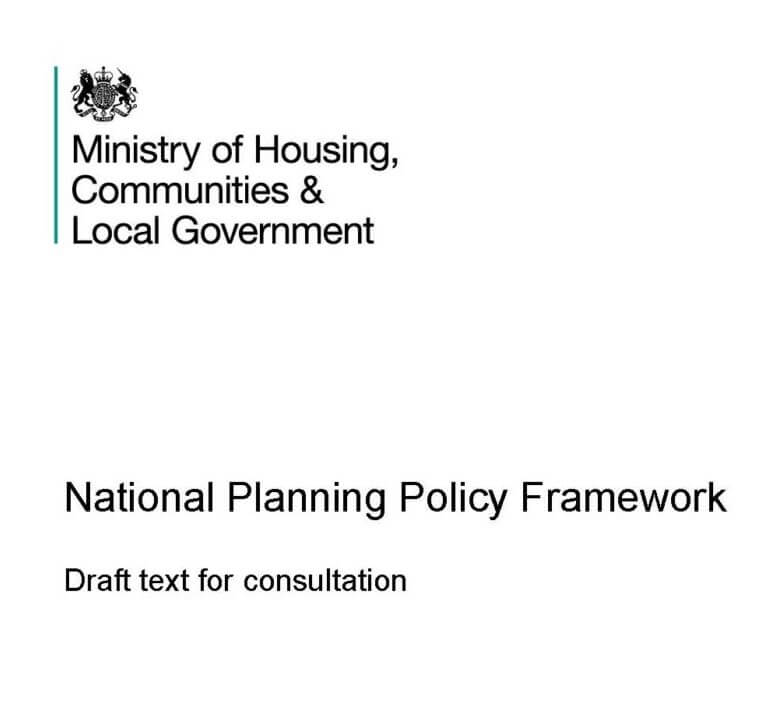
Reclaiming mineral sites to agriculture
Jan 29th 2018DJA welcomes Andrew Short
Mar 14th 2018NPPF v2 consultation draft

Draft revised National Planning Policy Framework (NPPF)
On Wednesday 5th of March the government published the draft revised National Planning Policy Framework (NPPF), along with a raft of documents relating to housing delivery, viability and developer contributions/CIL.
The revised NPPF incorporates a number of policy proposals contained within the Housing White Paper and the Planning for the Right Homes in the Right Places consultation documents published last year.
As expected, the revised NPPF places great emphasis on the delivery of new homes, in order to meet the Government’s target of providing 300,000 new homes per year. The Government has said that maximising the use of land and a greater emphasis on converting planning permissions into homes are at the heart of new planning reforms to deliver the homes England needs.
Key points:
Housing delivery
- A standard approach (yet to be published) will determine the minimum number of homes needed within each Authority, which will need to be provided unless exceptional circumstances can be demonstrated.
- A new Housing Delivery Test is proposed to measure each planning authority’s performance in delivering new houses. If the Housing Delivery Test shows that there has been significant under delivery of housing over the previous three years, the local authority must include a 20% buffer in its supply of specific deliverable sites in order to achieve the required five years supply.
- Additional certainty attached to recently made Neighbourhood Plans, where the local planning authority has at least a three year supply and its housing delivery was at least 45% of that required over the previous three years
- Under the proposals in the draft revision, planning authorities will be required to prepare an action plan if housing delivery is less than 95% of the housing requirement. The presumption in favour of sustainable development applies if delivery falls below 75%.
- The draft revisions propose that planning authorities should ensure at least 20% of the sites allocated for housing in their local plans are 0.5ha or smaller.
- Planning authorities should consider imposing a planning condition on housing permissions, requiring that development must begin within a timescale shorter than the relevant default period, where this would not threaten its deliverability or viability.
Density
- The draft revisions propose a tougher approach to density. Plans will be expected to include minimum density standards for locations well served by public transport. This applies where there is a shortage of land for meeting housing need.
- Promotion of the use of airspace above existing residential and commercial premises for new homes, allowing upward extensions where the development would be consistent with the prevailing height and form of neighbouring properties and the overall street scene.
Landscape
- There is no clarification on the vexing issue of “valued landscape” other than a change to the paragraph number, 109 has become 168.
Brownfield land
- The draft revisions propose stronger wording for support of the redevelopment of brownfield land. It proposed to give substantial weight to the value of using suitable brownfield land within settlements.
Green Belt
- Tightening of green belt policy such that, before ‘exceptional circumstances’ justifying the amendment of Green Belt boundaries can be concluded, local authorities ‘should have examined fully all other reasonable options for meeting [their] identified need for development’. Options include optimising use of suitable brownfield sites/underutilised land; optimising density of development; and demonstrating discussions with neighbouring authorities about meeting unmet need (through a proposed Statement of Common Ground)
- Affordable housing on previously development land, where it would not cause substantial harm to openness and would contribute to meeting an identified need, will not be considered “inappropriate”.
Minerals
- No major changes but the consultation does seek views on whether national and sub-national guidelines on future aggregates provision remains a relevant approach.
The consultation runs until the 10th May 2018. If you would like to discuss any of the consultation documents, please contact us.
DCLG consultation website: https://www.gov.uk/government/consultations/draft-revised-national-planning-policy-framework


